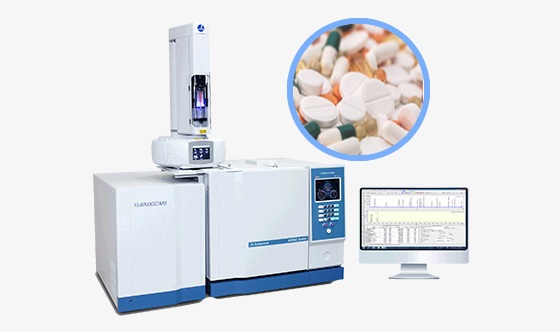Residual Solvent Analyzer (YL6500 GC)
Residual Solvent Analyzer can accurately and efficiently detect and quantify residual solvents classified as different levels by
various regulations by using headspace method.
For pharmacopeial purposes, residual solvents in pharmaceuticals are defined as organic volatile chemicals
that are used or produced in the manufacture of drug substances or excipients, or in the preparation of drug
products.
Also, organic residual solvents found in the inks used for the printing of packaging materials for food and drug
products are known to be hazardous to human health if ingested.
On the United States Pharmacopoeia <467>, the residual solvents are classified as “Organic Volatile Impurities
(OVIs)” and regulates the concentration of toxic solvents contained in medicine. European Pharmacopoeia also
describes “Identification and control of residual solvents”.
Residual Solvent Analyzer can accurately and efficiently detect and quantify residual solvents.

Residual Solvent Analyzer
Organic residual solvents used in the manufacture of pharmaceuticals and found in the inks used for the printing of
packaging materials for food and drug products are known to be hazardous to human health if ingested. YL Residual
Solvent Analyzer can accurately and efficiently detect and quantify residual solvents.
• Useful Information
• Sample Injection Condition
* Pharmaceutical raw materials
Incubate the vial containing the standard and the sample in the Headspace Autosampler in a dry oven for 60 minutes
at
85 °C. Sample 1.0 - 1.5 ml of above the gas phase from the vial with a gastight syringe and inject it.
Note that the incubation
temperature and time are flexible, which is based on the boiling points of the organic
solvents.
* Food packaging materials
Inject 1.0 – 1.5 ml of the gas phase sampled by a gastight
syringe after heating the tripod flask
containing the
standards and the sample in a dry oven for 30 minutes at
80 °C.
• Automation
Headspace Autosampler can make automation of sample
preparation and Injection to the Residual Solvent Analyzer.
• Recommended Columns
-
Food packaging material: G1 or G5 (30 m, 0.32 mm, 1.0um)
- Pharmaceutical raw materials: G16 (30 m, 0.53 mm, 1.0 µm),
G43, G1
• Application
-
Residual solvents in food packaging materials
- Residual solvents in pharmaceutical raw materials
Solvent Mixture
•Oven : 35 °C (10 min) 5 °C/min 160 °C (5 min)
•Column : HP-INNOWAX (60 m, 0.32 mm, 0.5 µm)
•Carrier gas : He / 1 ml (Split ratio 100:1)
•Injector : Capillary 250 °C
•Detector : FID 300 °C
1. Acetone
2. Ethyl acetate
3. Iso propyl acetate
4. Methanol
5. Methyl ethyl ketone
6. Iso-propanol
7. Methyl isobutyl ketone
8. Toluene
9. Butyl acetate
10. Isobutyl is obutyrate
11. Iso-butanol
12. p-xylene
13. Xylene impurity
14. Propylene glycol –
monomethyl ether
15. Butanol
16. o-xylene
17. Ethyl cello solve
18. Cello solve acetate
19. Cyclohexanone
20. Diacetone alcohol
21. Butyl cello solve
Residual Solvent in The Food Packing Materials
•Oven : 35 °C (5 min) 10 °C/min 150 °C (5 min)
•Column : HP-5 (30 m, 0.32 mm, 1.0 µm)
•Carrier gas : He, 3 ml/min (Split ratio 10:1)
•Injector : Capillary 230 °C
•Detector : FID 250 °C
•Headspace : 80 °C, 30 min Heating, Gas 1 ml Injection
1. MeOH
2. EtOH
3. IPA
4. MEK
5. EA
6. THF (ISTD)
7. Tol
8. BA
9. PMA
Residual Solvent on Class 2
•Oven : 35 °C (5 min) 5 °C/min 100 °C (0.1 min)
13 °C/min 200 °C (5 min)
•Column : HP-INNOWAX (30 m, 0.53 mm, 1.0 µm)
•Carrier gas : He, 6 ml/min (Split ratio 5:1)
•Injector : Capillary 230 °C
•Detector : FID 250 °C
•Headspace : 80 °C, 60 min Heating, Gas 1 ml Injection
2. Cyclohexane
3. Methyl cyclohexane
4. Trichloroethylene
5. Dichloromethane
6. Dichloroethylene
7. Toluene
8. Ethyl benzene
9. p-Xylene
10. m-Xylene
11. o-Xylene
12. chlorobenzene
13. DM
1. n-Hexane